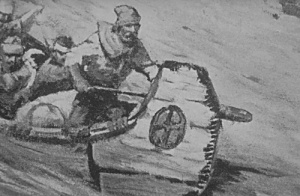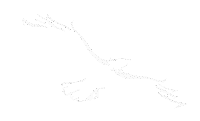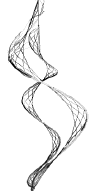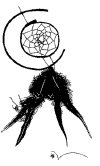Snowshoes and the Fur Trade
Winter Gifts
Indians have always contributed to the prosperity of other
Americans. Just as the Mille Lacs Bandís gaming enterprises benefit the
communities today, the great fur trade business, which flourished in the
early days of our country, would not have existed without the gifts of the
American Indians.
 In
the early nineteenth century, fur trading was one of the largest economic
forces in the United States. John Jacob Astor, once considered the richest
man in America, first amassed his fortune by trading goods for furs trapped
by Ojibwe and other northeastern Indians.
In
the early nineteenth century, fur trading was one of the largest economic
forces in the United States. John Jacob Astor, once considered the richest
man in America, first amassed his fortune by trading goods for furs trapped
by Ojibwe and other northeastern Indians.
The furs of animals that lived in northeastern United
States and Canada were a valuable commodity in cold northern Europe and in
the mountains of China. Because these furs were thickest and most beautiful
in winter, it was necessary to trap animals when the snow was deep.
This presented a problem. Early European frontiersmen had
no knowledge of trapping. Hunting was considered "recreation" in Europe, and
only the very wealthy were allowed to hunt or trap. Because most European
settlers came from poor families and lacked hunting knowledge, Astorís
enterprise and others like it would never have survived without American
Indian know-how.
The American fur business depended completely on Indians.
Indian men, who were skilled hunters, would trap the animals and bring them
back to hunting camps where Indian women would carefully process them for
market. The age-old process the Indians used provided the softest, most
pliable skin and fur, and was in very high demand.
The fur business also depended on Indian transportation.
Horses and wagons, used in Europe, were useless in deep snow. Indians had
developed the best methods of transporting goods in winter ó toboggans
pulled by dogs and snowshoes. These two inventions allowed people and goods
to travel on top of snow, and made it possible to ship furs across America.
Until modern times and the invention of the snowmobile, snowshoes and
toboggans provided the most efficient ways to convey goods across snow.
Snowshoes: An American Indian Invention
In the deep of winter, traditional Ojibwe hunters strapped
on snowshoes to
maneuver through thick snow. Aagimug (snowshoes), which were developed by
American Indians in the Great Lakes region, allowed the hunters to move more
easily in their efforts to feed their families.
Traditional snowshoes were made of two basic parts: a
hardwood frame and a netting made of hide, twine or sinew (animal tendon).
Wide and strong, snowshoes distributed the hunterís weight across a larger
surface, preventing him from sinking into the snow.
Ojibwe People called the rounded type of snowshoe the
"bear paw" because the contraption left a bear-like print in the snow
(legend even stated that crafty bears wore similar devices for quicker
movement through the snow). Other American Indian tribes referred to the
snowshoes as "catfish" because of their shape.
Although the Great Lakes Indians had used the devices for
centuries, Europeans trappers and hunters had never seen snowshoes before
meeting Indians. Most Europeans, new to the region, relied on horses for
transportation, but the deep snow made this kind of travel nearly impossible
in the winter. So, after forging friendships with local Indians, European
trappers and hunters began using snowshoes, too.
Few people, Indian or non-Indian, continue to trap or hunt
during the winter. But snowshoes are now known throughout the world and are
widely used for sport and recreation.
Settlersí Impact
The Ojibwe Indians first came in contact with French fur
traders when the Ojibwe People lived along the eastern seaboard. The French,
who based their economy on fur trade, soon understood that the Indians were
more skilled at trapping animals than they were. So, instead of trapping
themselves, the French would trade with the Indians for fur. In return, the
French gave the Indians manufactured goods such as guns, knives, kettles,
glass and cloth. The French then sold their fur to other Europeans.
As the East became colonized by Europeans, the tribes
moved West ó and so did the fur traders. When the Ojibwe People settled in
the woodlands of north central Minnesota, they continued their fur trading
relationship with the French. Through trading their resources, the two
groups maintained a friendly relationship.
Today, several Indian bands still have French names, such
as the Fond du Lac ("far end of the lake") Band and the Mille Lacs
("thousand lakes") Band. During their interactions with the Indians, the
French acquired some Ojibwe expressions, too.
The British, however, were a different story. Their
economy was based on land ownership and farming. They looked at this vast
continent and decided that the land was theirs to sell. They took it away
from the Indians and sold it to British settlers.
This created tension between the Indians and the British,
and as time progressed, this tension led to many bloody battles. The British
were willing to destroy anything that stood in the way of obtaining land.
They burned down entire villages and murdered Indian men, women and
children. This was a very tragic time in American Indian history. It changed
the Indian Peoplesí lives forever.
White Eagle Soaring: Dream Dancer of the 7th Fire







 Get
a course to promote your business online, explode your sales
Get
a course to promote your business online, explode your sales Get
software to promote your business online in less time
Get
software to promote your business online in less time Get
software to streamline your business and run it hands free.
Get
software to streamline your business and run it hands free. In
the early nineteenth century, fur trading was one of the largest economic
forces in the United States. John Jacob Astor, once considered the richest
man in America, first amassed his fortune by trading goods for furs trapped
by Ojibwe and other northeastern Indians.
In
the early nineteenth century, fur trading was one of the largest economic
forces in the United States. John Jacob Astor, once considered the richest
man in America, first amassed his fortune by trading goods for furs trapped
by Ojibwe and other northeastern Indians. 